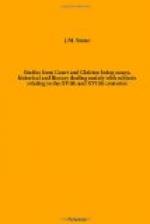The best means of stretching vellum to its original dimensions, after it has been shrivelled and contracted, had not at that time been discovered, but the restorers did what they could. It was first softened in cold water, then those leaves, which had become glued together by the heat melting all kinds of extraneous matter, were separated by means of an ivory cutter, and the glutinous substances carefully removed with the fingers, the parchments smoothed with the palm of the hand, and their backs pressed with a clean flannel. Fragments were also carefully cleaned and preserved, and upon many of these with which the original restorers could do nothing, Sir Frederick Madden afterwards worked wonders. By his method, 100 volumes were repaired on vellum, and 97 on paper.
Among these mutilated fragments was the priceless fourth century manuscript of Genesis, Otho, B 6, which was thought to have been taken abroad as it could not be found after the fire. For a while it was given up as irrevocably lost, but Sir Frederick Madden discovered the much burnt remains and pieced them together. This Book of Genesis was at one time thought to be the oldest Greek Ms. in England. It is now known that the four leaves of the gospel in Greek, Titus, C 15, are as old or even older. The Oxford librarian, Thomas James, wrote in the beginning of the volume that it was brought into this country by two Greek bishops as a present to Henry VIII. They told him that according to an old tradition it had belonged to Origen, and there was nothing in the text to make the supposition incredible. This, if true, would carry the manuscript back 1500 years at least, with a possibility of its being much more ancient. It had been the subject of a dispute in the time of the first Sir John Cotton, when it was supposed to have been lost. All at once it was discovered in the possession of Lady Stafford, who stoutly maintained that it had belonged to the late earl, her husband, who had lent it to Sir Thomas Cotton; and that while it was in his hands he caused it to be newly bound, and his coat of arms fixed upon it. She said, however, that Sir John might have it for 40 pounds, but that she would not take a farthing less, adding that he had already offered her 30 pounds in her own house, but that she had refused the sum. Mr. Gilbert Crouch, who was negotiating for Sir John, in explaining the matter to Dugdale, said that if Sir John Cotton had “so great a mind to the book, he were better give this other 10 pounds than run the charge and hazard of a suit."*
* Life, Diary, and Correspondence of Sir William Dugdale.
All that now remains of this uniquely beautiful Ms., painted on every page, are eighteen melancholy scraps of no use but as a monument of the ingenuity with which they have been pieced together, mended, and preserved.
The Chronicle of Wendover, which was also believed to have perished, was found and repaired in the time of Sir Frederick Madden.




